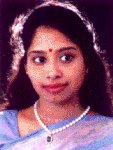
|
 |

|
 |
THE MUSICAL GENIUS OF THE TANJAVUR QUARTETTE by Gowri Ramnarayan (Natya Kala Conference 2000) Aug 2001 Ten centuries ago, South Indian music and dance had reached high levels of sophistication in Tanjavur, where royal patronage of three dynasties (Chola, Nayaka, Maratha) and the connoisseurship of the people, had nurtured the arts with love and discernment. Among the galaxy of poets, musicians and composers of that green belt, the Tanjavur Quartette of the brothers Chinnayya, Ponniah, Sivanandam and Vadivelu (early 19th century) stand out for their attainments in both dance and music. They are credited with having systemized the "margam" of what we know as Bharatanatyam today. Apart from the continuation of their tradition through natyacharyas in their own family, like the late Kittappa Pillai and Subbaroya Pillai, their unmistakable stamp is left on the entire genre through the two major (and contrastive) influences of Balasaraswati and Rukmini Devi. Their gurus Kandappa Pillai and Minakshisundaram Pillai carried the legacy of the Tanjavur Quartette. Born in a family of oduvars (temple musicians) the brothers inherited a sense of laya and raga, along with the spiritual heritage of a ritualistic art. This was strengthened when they became disciples of Muthuswami Dikshitar. With patronage from the Maratha rulers (Serfoji II and Sivaji II), the Mysore court, and from Swati Tirunal in Travancore, they established themselves not only as vidwans and nattuvanars, but also as composers of merit, mostly paying homage to Brihadisvara, the reigning deity of Tanjapuri, and to their royal patrons. Some of the songs express their devotion to their guru, and their pride in him. Their collective works span a variety of compositions for both music and dance - tana pada varnam, kriti, padam, javali, swarajati, daru, kavuttuvam, sooladi and tillana. Sivanandam excelled as a veena player and was an expert in abhinaya; while Vadivelu popularised the western violin in Carnatic music, and contributed to the growth of Mohiniyattam in Kerala. It is evident that the brothers viewed classical dance and music as allied art forms. This imparts a special glow to their compositions in both the rhythm and bhava aspects. The ragas are treated with imagination, depth and respect for tradition. The compositions offer tremendous scope for emotional interpretation, not only for the dancer, but for the musician as well. Carnatic musicians have not drawn as much from the heritage of the Tanjavur Quartette as the dancers have done, despite the fact that their compositions are steeped in ragabhava, reflecting many moods. There is variety here, for both expansive treatment and for lighter expressions. Nithyasree Mahadevan, who herself belongs to a tradition which excels in rendering compositions with their ragabhava and artha bhava intact, presented some of the treasures of the celebrated Tanjavur Quartette whose works are seen as collective creations. With their balance of melody and rhythm, and their mingling of a madhyama kala pace and softer touch to the grand Dikshitar School, these compositions make excellent concert fare for the Carnatic musician.  Granddaughter of the legendary D K Pattammal (paternal) and mridangam maestro Palghat Mani Iyer (maternal), Nithyasree Mahadevan trained under D K Pattammal and Lalitha Sivakumar. She has been performing since 1987, her maiden performance being for YACM during their 2nd anniversary celebrations which won her the best main artiste award. She has given concerts for most of the major organizations all over India as well as abroad. She has received many awards notably Yuva Kala Bharathi, Sangeetha Sikhamani, Ugadi Puraskar, Nadabhushanam, and Kalaimamani. Nithyasree has received many awards for her film songs and has released about 40 cassettes and 3o discs to her credit on various themes. |